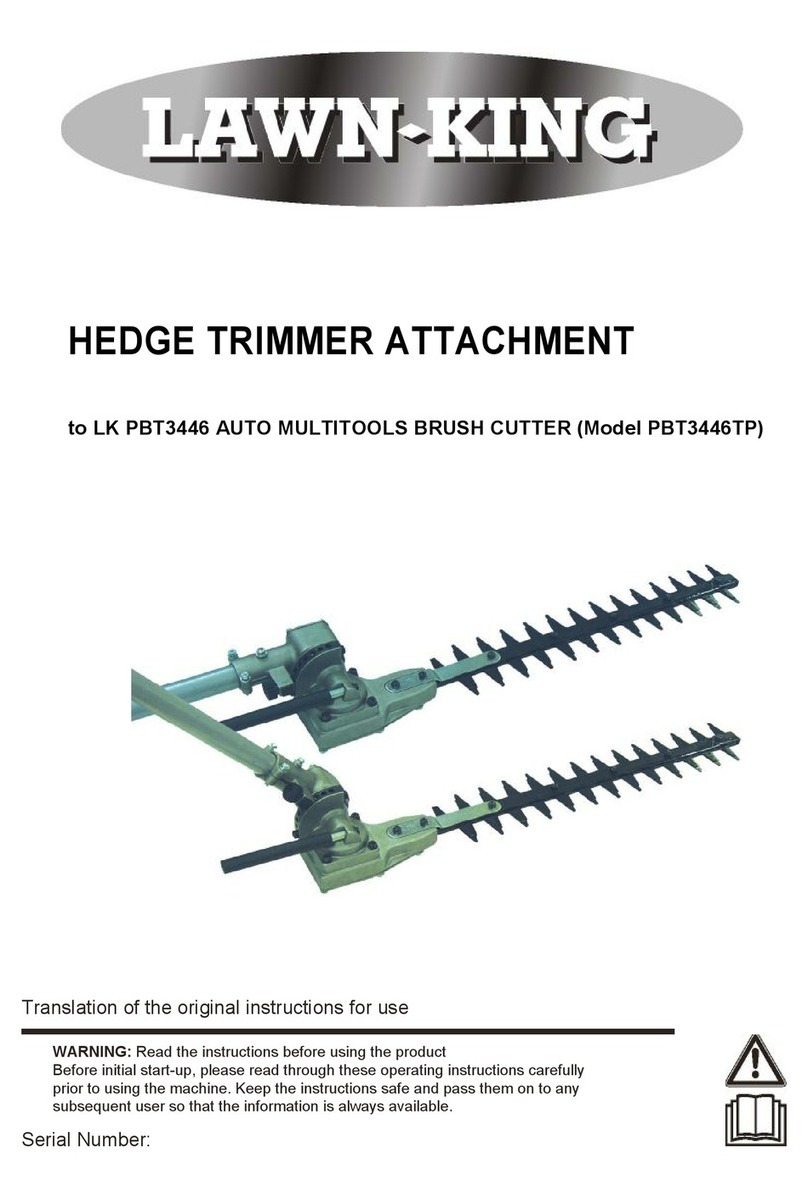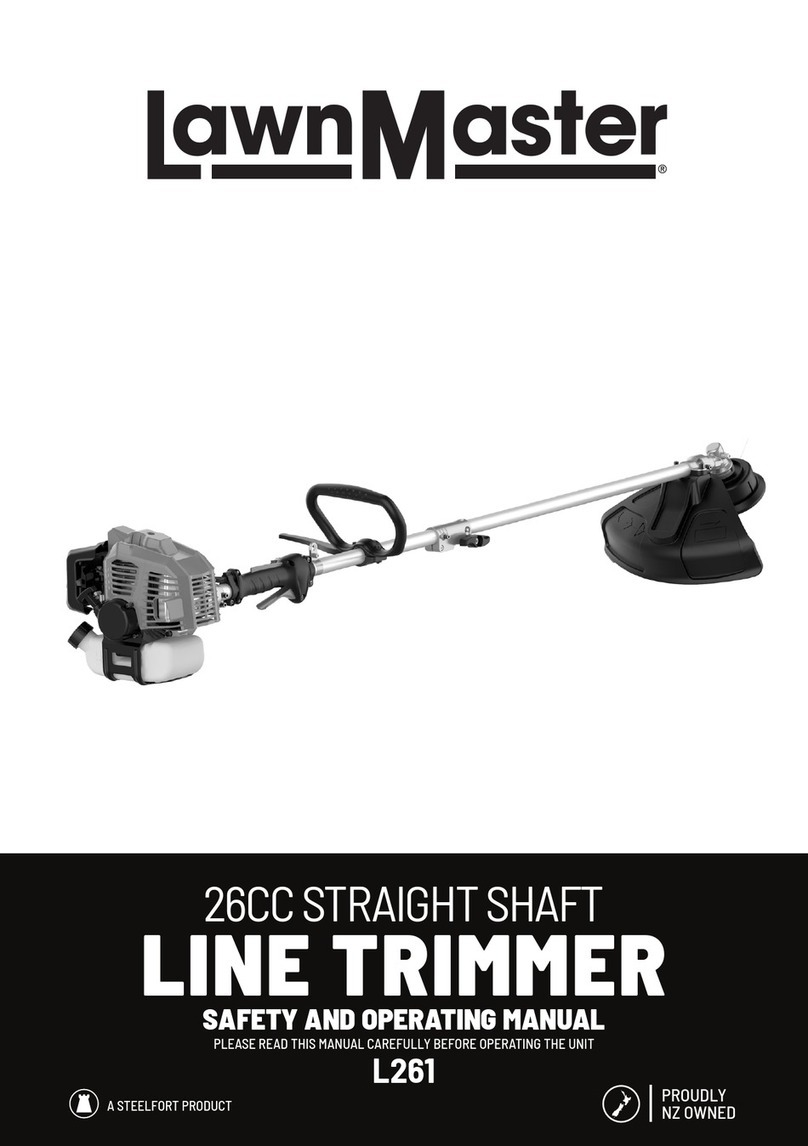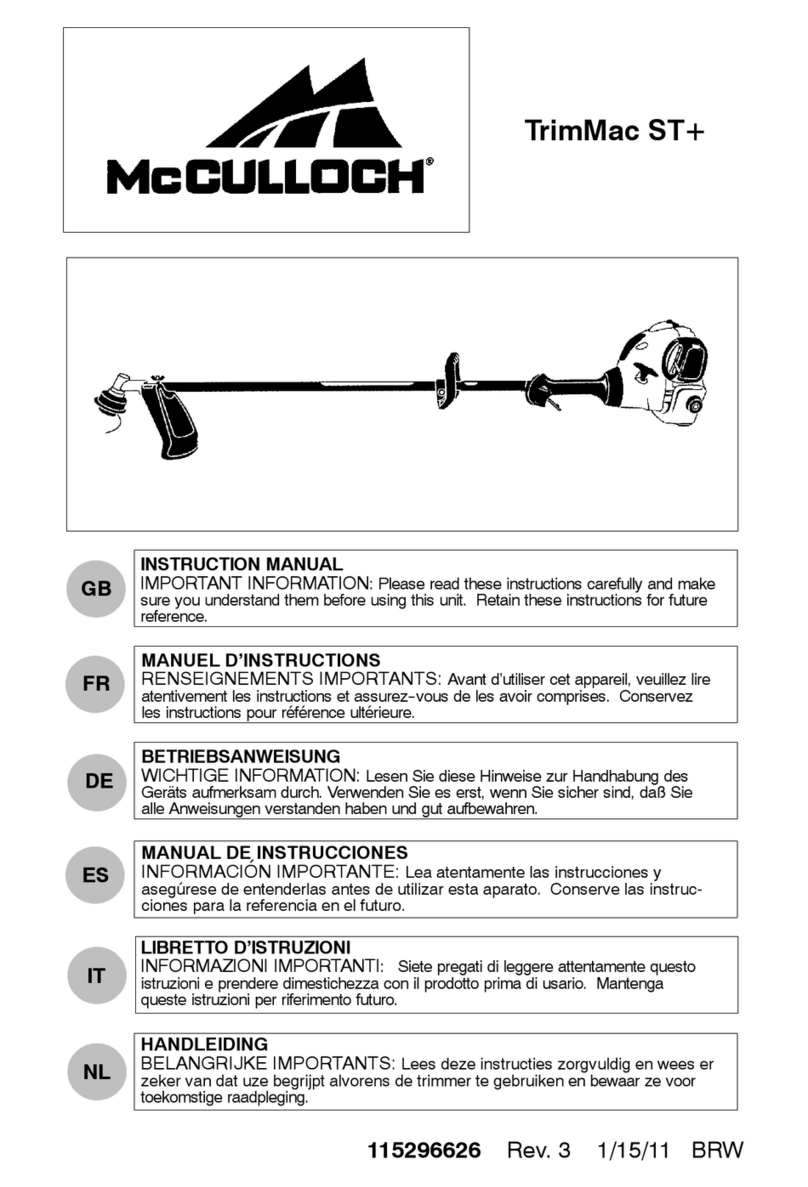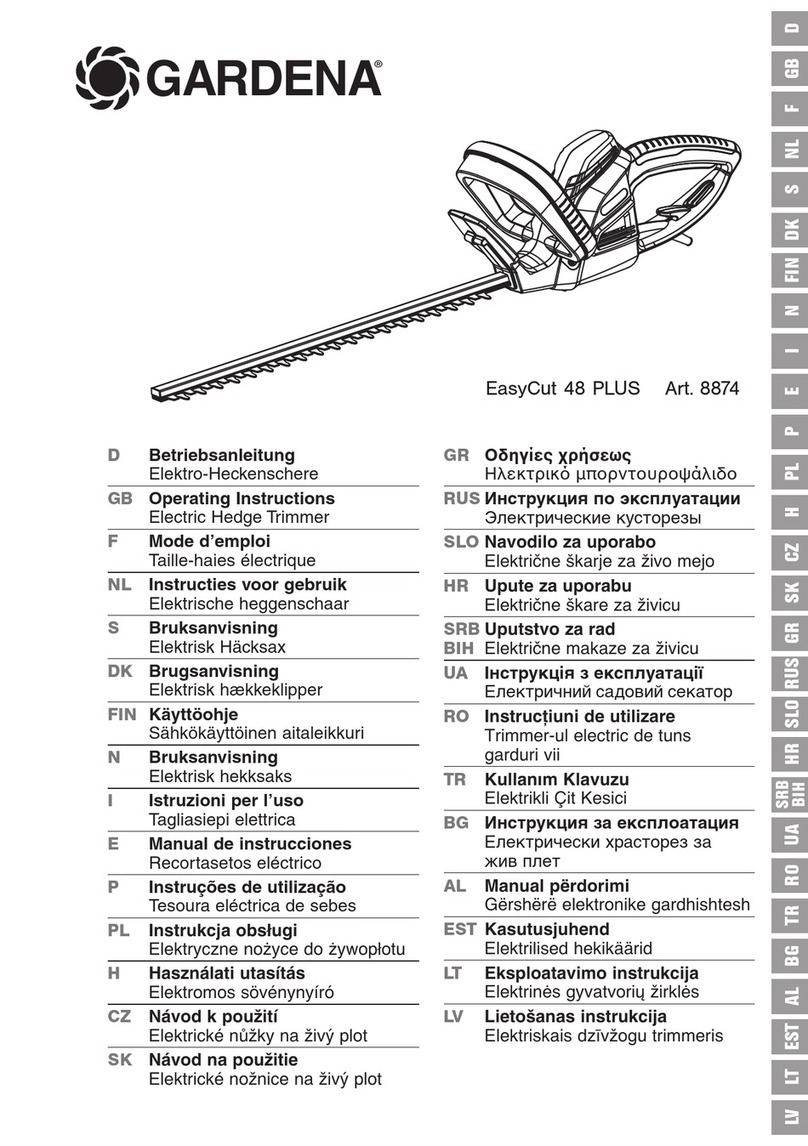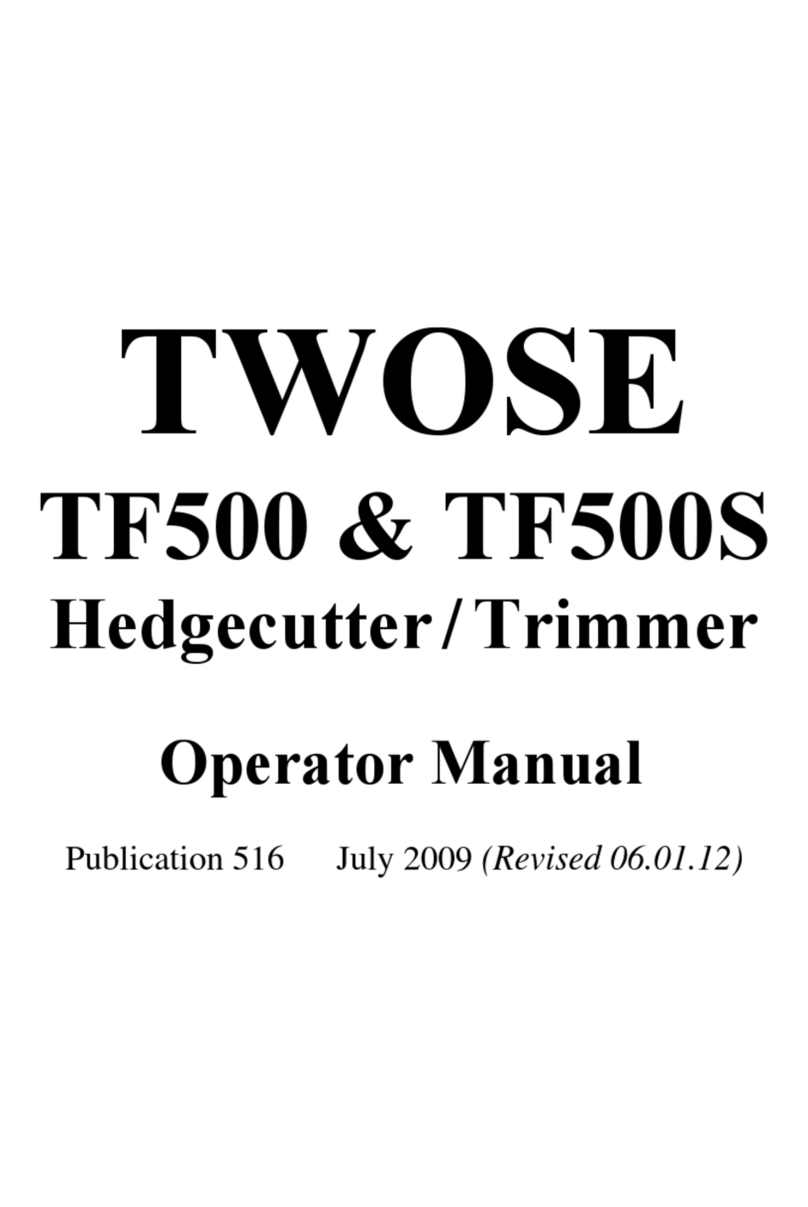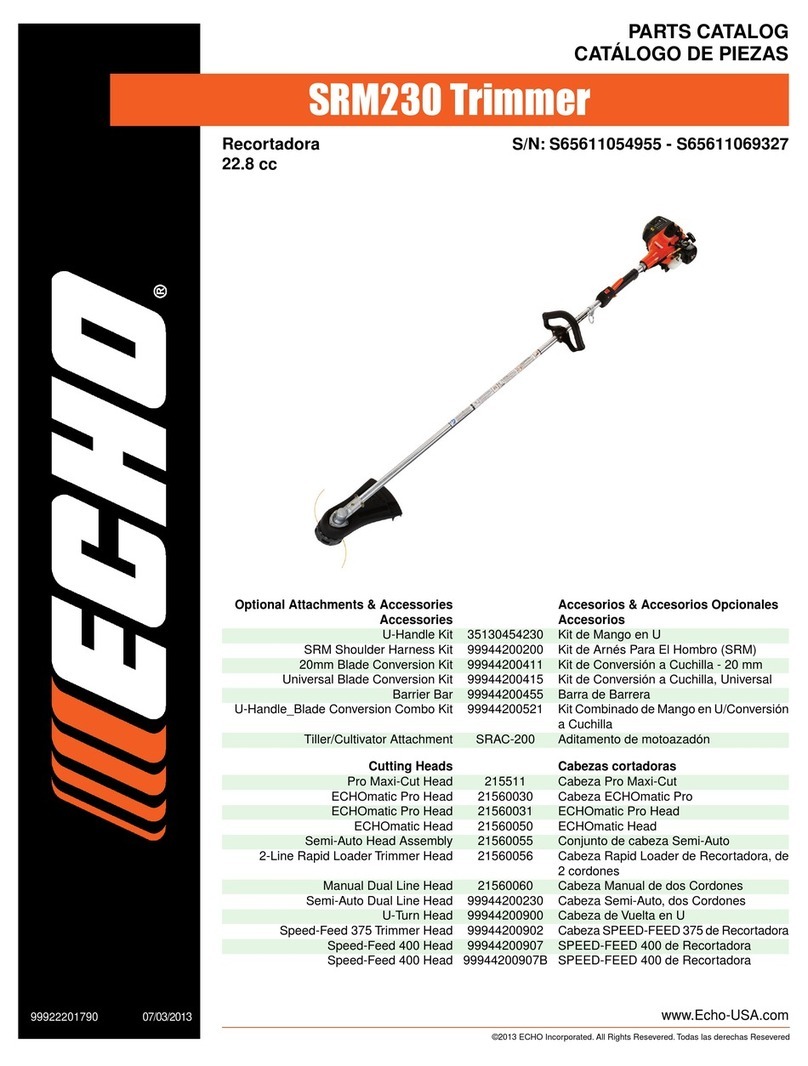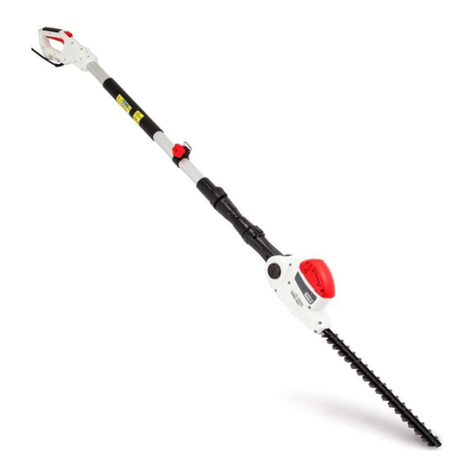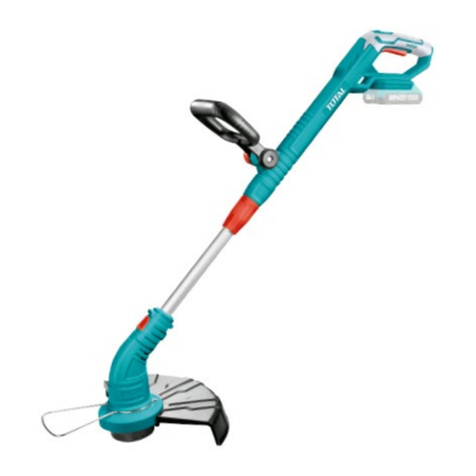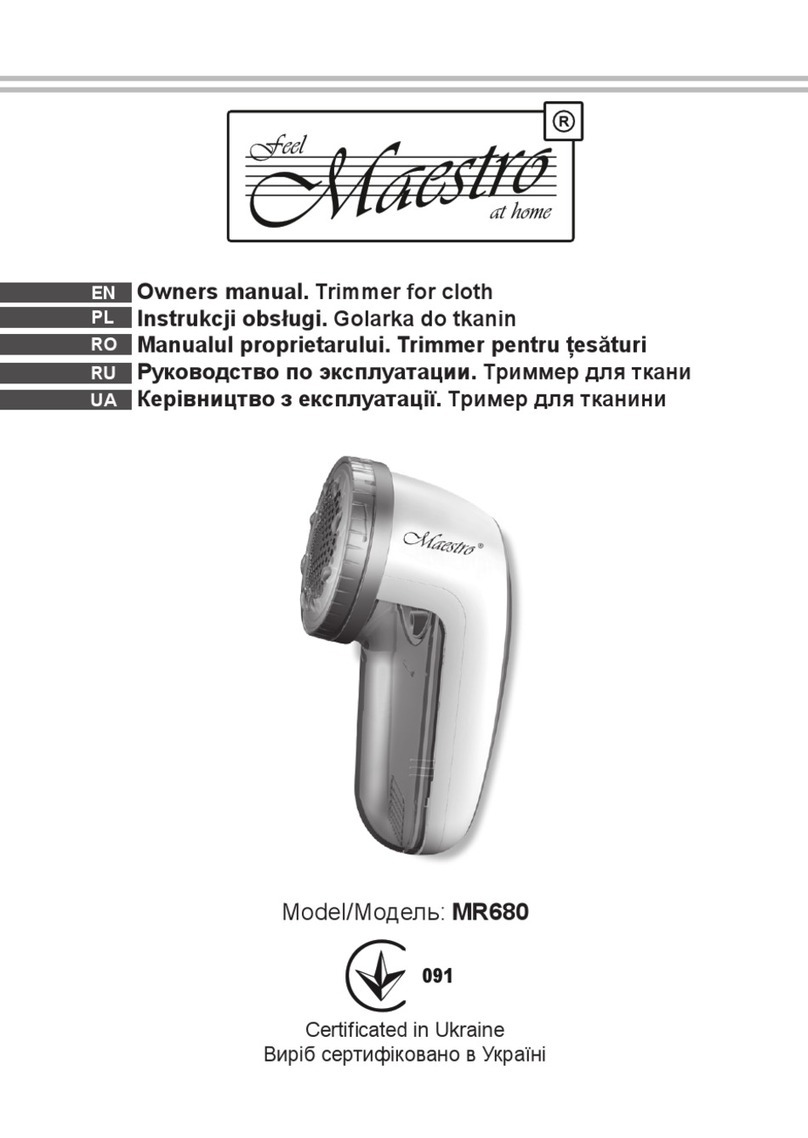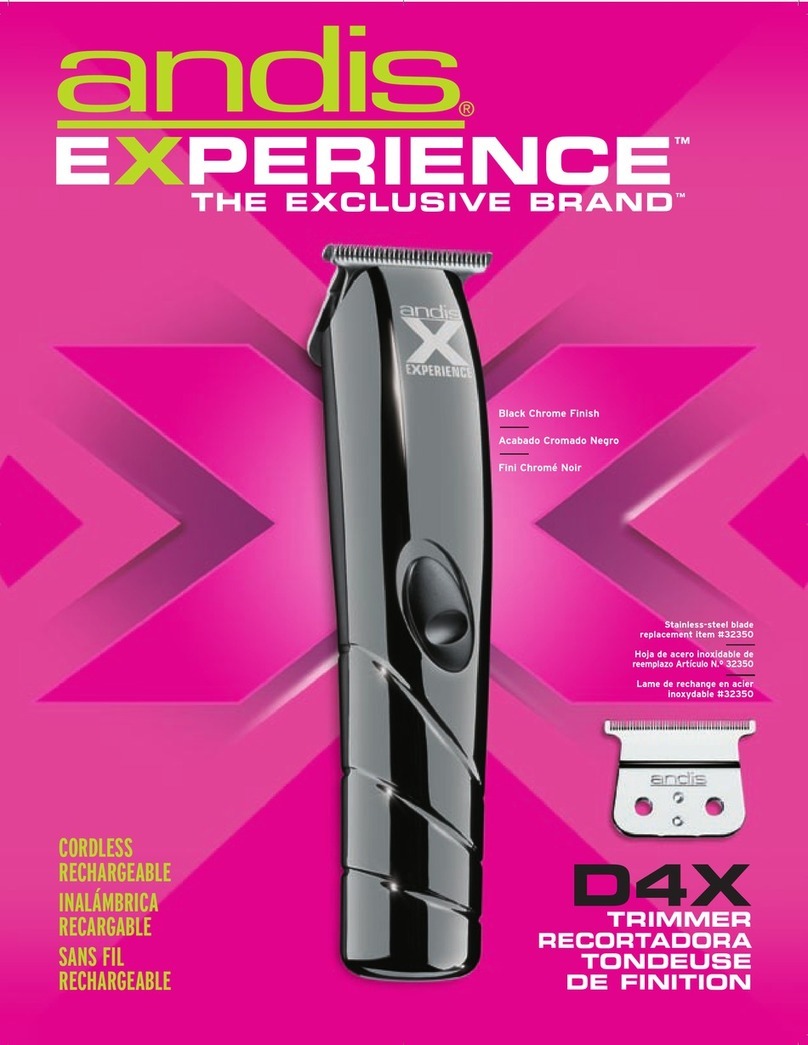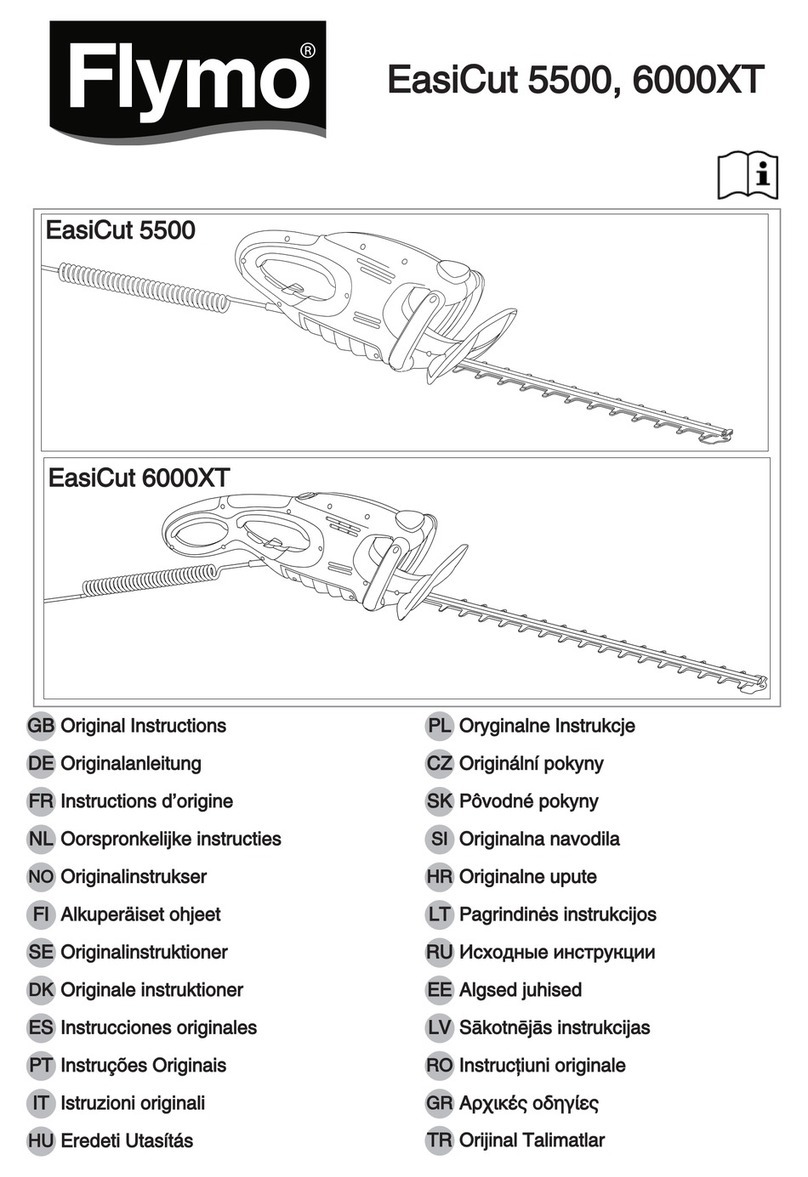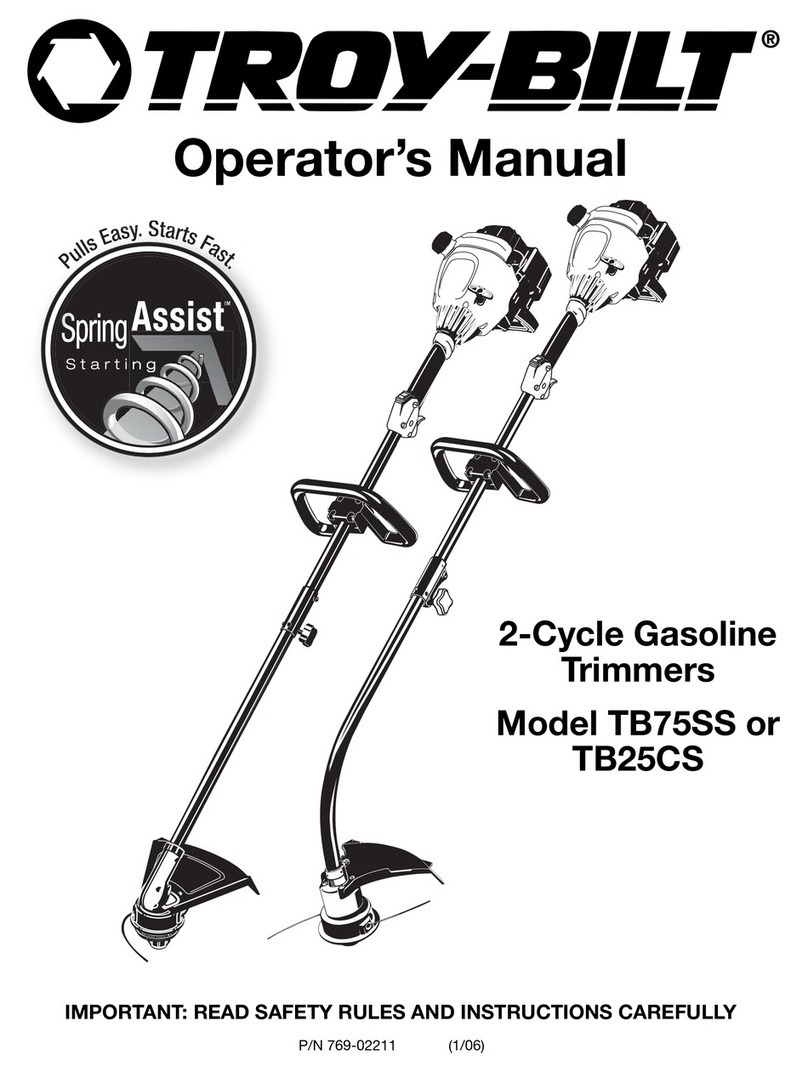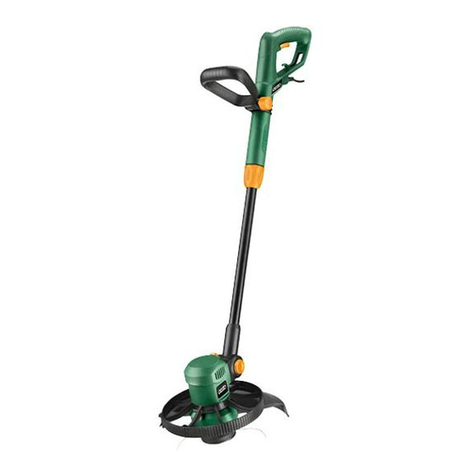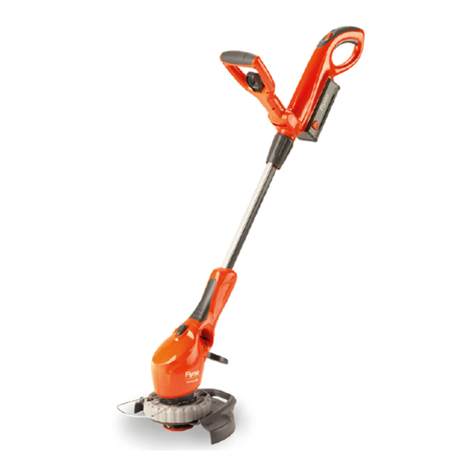Lawn-King LK PRT3043 AUTO Service manual

1
PETROL
TRIMMER
Translation of the original instructions for use
WARNING: Read the instructions before using the product
Before initial start-up, please read through these operating instructions carefully
prior to using the machine. Keep the instructions safe and pass them on to any
subsequent user so that the information is always available.
Serial Number:

2
Dear Customer,
Thank you for choosing one of our products. We hope that you will be completely satisfied with
this machine and that it fully meets your expectations. This manual has been compiled in order to
provide you with all the information you need to get acquainted with the machine and use it
safety and efficiently. Don't forget that it is an integral part of the machine, so keep it handy so
that it can be consulted when necessary, and pass it on to a further user if you resell the
machine.
Your new machine has been designed and manufactured in pursuance with current regulations,
and is safe and reliable if used in compliance with the instructions provided in this manual
(proper use). Using the machine in any other way, or non-compliance with the safety
specifications relative to use, maintenance and repair is considered "improper use" which will
invalidate the warranty, relieve the manufacturer from all habilites, and the user will consequently
be liable for all and any damage or injury to him or others.
Since we regular improve our products, you may find slight differences between your machine
and the descriptions contained in this manual. Modifications can be made to the machine without
notice and without the obligation to update the manual, although the essential safety and function
characteristics will remain unaltered. In case of any doubts, please contact your dealer. And now
enjoy your work!
TABLE OF CONTENTS
1. Identification of the main components ..........................
2. Symbols.......................................................................
3. Safety requirements.....................................................
4. Machine assembly.......................................................
5. Preparing to work.........................................................
6. How to start - Use —Stop the engine ..........................
7. Using the machine.......................................................
8. Maintenance and storage.............................................
9. Troubleshooting...........................................................
10. Disposal / Environmental protection .............................
10. Guarantee....................................................................
11. Technical data + CE Declaration of Conformity.............

3
1. IDENTIFICATION OF MAIN COMPONENTS
MAIN COMPONENTS
1. Power unit
2. Drive tube
3. Drive tube terminal
4. Cutting line head
5. Cutting device guard
6. Front handle
7. Rear handles with controls
CONTROLS AND REFUELLING
21. Engine stop switch
22. Throttle trigger
23. Throttle trigger lockout
24. Spark plug
25. Choke (auto-choke)
26. Primer
31. Fuel tank cap
32. Fuel tank
33. Starter

4
2. SYMBOLS
On the equipment, there are information symbols. These convey important information
about the product or information about the use.
CAUTION: special safety measures are required when handing the unit!
The entire operating instructions must be read and understood before use. Non-observance
of the operating instructions may be fatal!
1. Maximum rotational frequency of spindle
.
2. Attention to cutting devices and thrown objects.
3. Caution! Fuel and fuel fumes are flammable. Risk of fire and explosion!
4. Read the operating instructions carefully before using the equipment!
5. NEVER use cutting blades! ONLY nylon head on this product.
6. Wear eye, ear and head protection.
7. Wear protective gloves. Risk of injury from cuts.
8. Wear safety boots with sturdy soles.
9. Maintain a safety distance of min. 15 m from others.
10.Danger from parts being thrown out! Keep away from other people.
11.Use only nylon head.

5
12. Specification of the guaranteed sound power level LWA in dB.
13. Caution! Hot surfaces –risk of burns!
14. Symbol on the choke lever
Lever in cold start position (START)
Lever in warm start position (RUN)
15. Symbol of fuel pump: press the fuel pump 10x before starting.
16.Mix ratio 40:1, use ONLY fuel mix.
17.Conforms to current standards.

6
3. SAFETY REQUIREMENTS
A) TRAINING
1) Read the instructions carefully. Become acquainted with the controls and the proper use of
the machine. Learn how to stop the engine quickly.
2) Only use the machine for the purpose for which it was designed, namely
- cutting grass and non-woody vegetation, using a nylon line (e.g. around the edges of lawns,
flowerbeds, walls, fences and small grassy areas to tidy up the cutting done using a mower);
Any other use may be dangerous and damage the machine.
3) Never allow children or persons unfamiliar with these instructions to use the machine. Local
regulations can restrict the age of the user.
4) The machine must never be used by more than one person.
5) Never use the machine:
- When people, especially children or pets are in the vicinity;
- if the user is tired or unwell, or has taken medicine, drugs, alcohol or any substances which
may slow his reflexes and compromise his judgment;
- If the user is not capable of holding the machine firmly with two hands and/or remaining
standing on the ground whilst working.
6) Keep in mind that the operator or user is responsible for accidents or hazards occurring to
other people or their property.
B) PREPARATION
1) Always wear adequate clothing which does not hamper movements when using the machine.
- Always wear slim-fitting protective clothing, fitted with shear-proof protection devices.
- Always wear a helmet, protective gloves, eye goggles, a half-mask respirator and safety anti
shear boots with non-slip soles.
- Always wear ear and hearing protection devices.
- Never wear scarves, shirts, necklaces, or any hanging or flapping accessory that could catch in
the machine or in any objects or materials in the work area.
- Tie your hair back if it is long.

7
2) WARNING: DANGER! Petrol is highly flammable:
- keep the fuel in containers which have been specifically manufactured and homologated for
such use;
- Never smoke when handling fuel;
- Slowly open the fuel tank to allow the pressure inside to decrease gradually;
- Top up the tank with fuel in the open air, using funnel;
- add fuel before starting the engine. Never remove the fuel tank cap or add fuel while the
(engine is running or when the engine is hot;
- if you have spilt some fuel, do not attempt to start the engine but move the machine away) from
the area of spillage and avoid creating an) source of ignition until the fuel has evaporated and
fuel vapors have dissipated;
- Immediately clean up all traces of fuel spilt or the machine or on the ground;
- Never start the machine in the same place you refilled it with fuel;
- make sure your clothing does not come into contact with the fuel, on the contrary, change your
clothes before starting the engine;
- Always put the tank and fuel container cap: back on and tighten well.
3) Replace faulty or damaged silencers.
4) Before using the machine, check its general condition and in particular:
- The throttle trigger and the safety lever must move freely, they must not need forcing an should
return automatically and rapidly back to the neutral position;
- The throttle trigger must remain locked until the safety lever is pressed;
- The engine stop switch must easily move from one position to the other;
- the electric cables and in particular the spark plug cable must be in perfect condition to avoid
the generation of any sparks, and the cap must be correctly fitted on the spark plug;
- The machine handgrips and protection devices must be clean and dry and well fastened to the
machine;
- The cutting devices and guards must be undamaged.
5) Check the correct position of the handgrip: and the connection point of the webbing, and the
proper balance of the machine.
6) Thoroughly inspect the whole work area and remove anything that could be thrown up by the
machine or damage the cutting group or engine (stones, branches, iron wire, bones, etc.).

8
C) OPERATION
1) Do not start the engine in a confined space where dangerous carbon monoxide fumes car
collect.
2) Mow only in daylight or good artificial light.
3) Take on a firm and well-balanced position:
- Where possible, avoid working on wet, slippery ground or in any case on uneven or steel
ground that does not guarantee stability for the operator;
- Never run, but walk carefully paying attention to the lay of the land and any eventual obstacles;
- assess the potential risks of the ground to be mown and take all necessary precautions to
ensure your own safety, especially on slopes or on bumpy, slippery or unstable ground;
- work along the contour on slopes, never when walking up or down and always keep downhill of
the cutter.
4) make sure the machine is securely locked when you start the engine:
- start the motor in an area at least 9 meters from where you refueled;
- check that there is nobody within at least 15 meters of the machine's range of action;
- do not direct the silencer and therefore the exhaust fumes towards inflammable materials.
5) Do not change the engine governor settings or over speed the engine.
6) Do not strain the machine too much and do not use a small machine for heavy-duty works. If
you use the right machine, you will reduce the risk of hazards and improve the quality of your
work.
7) Check that when the machine is running idle, there is no movement of the cutting device and,
alter pressing the throttle trigger, the engine quickly returns to minimum speed.
8) Stop the engine:
- Whenever you leave the machine unattended.
- Before refueling.
- During movements between work areas.
9) Stop the engine and disconnect the spark plug cable:
- Before cleaning, checking or working on the machine;
- After striking a foreign object. Inspect the machine for any damage and make repairs before
restarting it again;

9
- If the machine starts to vibrate abnormally: find and remove the cause of the vibration
immediately;
- When the machine is not in use.
D) MAINTENANCE AND STORAGE
1) Keep all nuts, bolts and screws tight to be sure the equipment is in safe working condition.
Routine maintenance is essential for safety and for maintaining a high performance level.
2) Do not store the machine with fuel in the tank in an area where the fuel vapors could reach an
open flame, a spark or a strong heat source.
3) Allow the engine to cool before storing in any enclosure.
4) To reduce fire hazards, keep the engine, exhaust silencer and fuel storage area free from
sawdust, branches, leaves, or excessive grease; never leave containers with the cut debris
inside the storage area.
5) If the fuel tank has to be emptied, this should be done outdoors once the engine has cooled down.
6) Always wear protective gloves when handling the cutting device.
7) For safety reasons, never use the machine with worn or damaged parts. Damaged parts
are to be replaced and never repaired. Only use original spare parts. Parts that are not of the
same quality can seriously damage the equipment and compromise safety. The cutting tools
must always bear the manufacturer's trademark as well as a reference to the maximum working
speed.
8) Before putting the machine away, check you have removed wrenches or tools used for
maintenance.
9) Store the machine out of the reach of children!
E) TRANSPORTATION AND HANDLING
1) Whenever the machine is to be handled or transported you must:
- turn off the engine, wait for the cutting device to stop and disconnect the spark plug cap;
- Only hold the machine using the handles and position the cutting device in the opposite
direction to that used during operation.
2) When using a vehicle to transport the machine, position it so that it can cause no danger to
persons and fasten it firmly in place to avoid it from tipping over, which may cause damage or
fuel spillage.

10
F) HOW TO READ THE MANUAL
Certain paragraphs in the manual contain particularity significant information and are marked with
various levels of highlighting with the following meaning:
Or
These give details or further information on what has already been said, in
the aim to prevent damage to the machine.
WARNING! Non-observance will result in the risk of injury to oneself or others.
DANGER! Non-observance will result in the risk of serious injury or death to
oneself or others.
NOTE
IMPORTANT

11
4. MACHINE ASSEMBLY
The machine is supplied with some of the components disassembled and the
fuel tank empty.
WARNING! Mount the components very carefully so as slot to impair the safety
and efficiency of the machine. If in doubt, contact your dealer.
A. ASSEMBLING OF SPLIT SHAFT
1. Unscrew the coupling knob.
2. Insert the lower transmission tube by sliding it inside the upper
transmission one.
3. As per the insertion, slightly rotate the lower tube on the right and
on the left until the internal transmission shaft snaps into place.
4. The tubes are connected properly when the ball lock is in its
housing.
5. Tighten now the coupling knob to lock the shaft.
B. ASSEMBLING OF HANDGRIP
Position the handgrip, as shown, between the stop against the handgrip and the coupling knob, and
clip it.
Tighten the screw and the nut, so to fix the handgrip.
IMPORTANT

12
C. ASSEMBLING OF PLASTIC GUARD AND OF LINE CUTTER
Unscrew the plastic guard.
Slide the plastic guard along the lower transmission shaft, up to the « U » part, provided for this
purpose.
Place the plastic guard on the « U » aligning its holes with those of the « U » part.
Tighten the screw and tighten the plastic guard on the transmission shaft, so that it cannot come
loose during use, due to vibrations.
Once the plastic guard in place, remove the plastic cover from the line cutter,
which is located underneath the guard.
D. ATTACHING AND DETACHING OF RETAINING STRAP
Be equipped with a retaining strap.
Adjust the length and the width of the strap so to obtain a comfortable
position.
Hook or unhook the clasp of the strap at the attachment ring provided on the
shaft.

13
5. PREPARING TO WORK
CHECKING THE MACHINE
Before starting work please:
- Check that ail the screws on the machine and the cutting device are tightly fastened;
- check that the air filter is clean;
- check that the protection devices are well fastened and working efficiently;
- check the handgrips are well fastened.
PREPARING THE FUEL
This machine is fitted with a two-stroke engine which requires a mixture of petrol and lubricating oil.
Using petrol alone will damage the motor and will cause for invalidation of the
warranty.
Only use quality fuels and oils to maintain high performance and guarantee the
duration of the mechanical parts over time.
Petrol characteristics
Only use unleaded petrol with a fuel grade of at least 91 N.O.
Unleaded petrol tends to create deposits in the container if preserved for
more than 2 months. Always use fresh petrol!
Oil characteristics
Only use top quality synthetic oil specifically for two-stroke engines.
Your dealer can provide you with oils which have been specifically developed for this type of
engine, and which are capable of guaranteeing a high level of protection.
IMPORTANT
IMPORTANT
IMPORTANT

14
For synthetic oil, add 2, 5% oil to gasoline (refer to indications of oil), it
means 2, 5 cl of oil per 100 cl petrol.
Preparation and preservation of the fuel mixture
DANGER!
Petrol and the fuel mixture are highly inflammable!
- Keep the petrol and fuel mixture in homologated fuel containers, in safe place, away from
any flames or heat sources.
- Never leave the containers within the reach of children.
- Never smoke whilst preparing the mixture and avoid inhaling the petrol fumes.
To prepare the fuel mixture:
- Place about half the amount of petrol in a homologated tank.
- Add ail the oil, according to the above indication.
- Add the rest of the petrol.
- Close the top and shake well.
The fuel mixture tends to age. Do not prepare excessive amounts of the fuel
mixture to avoid deposits from forming.
Keep the petrol and fuel mixture containers separate and easily identifiable to
avoid the mistake of using one in place of the other.
Periodically clean the petrol and fuel mixture containers to remove any
eventual deposits.
REFUELLING
IMPORTANT
IMPORTANT
IMPORTANT

15
DANGER! Never smoke whilst refueling and avoid inhaling the petrol fumes.
WARNING! Carefully open the tank top as pressure could have formed inside.
Before refueling:
Shake the fuel mixture container well.
Place the machine on a flat stable surface, with the fuel tank cap facing upwards.
Clean the fuel tank cap and the surrounding area to avoid any dirt from entering the tank
during refilling.
Carefully open the fuel tank cap to allow the pressure inside to decrease gradually. Use a
funnel to refill and avoid filling the tank to the brim.
WARNING always closes the fuel tank firmly.
WARNING! Immediately clean all traces of fuel which may have dripped on the
machine or the ground and do not starts the engine until the petrol fumes have dissipated.

16
6. HOW TO START - USE - STOP THE ENGINE
STARTING THE ENGINE
WARNING! The engine must be started in an area at least 3 meters from where you
refilled the fuel tank.
Before starting the engine:
- ensure that the protective cap on the line cutter has been removed.
- Place the machine firmly on the ground.
To avoid overloading the engine upon ignition, make sure that the cutting line
head nylon wire is not over 13 cm long.
To avoid breaking the starter rope, do not pull the whole length of it or let it
slide along the edge of the cable guide hole. Release the starter gradually, to avoid letting it fly
back uncontrollably.
WARNING! Starting the engine with the starter engaged causes the cutting device
to move, only stopping when the starter is disconnected.
Starting the Engine (Picture 10):
Start the engine at least 3 meters from the filling location
Ensure that the protective cap on the line cutter has been removed.
1. Fuel
• Level the engine before fueling.
• Open the fuel tank cap and fill the fuel tank with 40:1 gas/oil-mixed fuel.
NOTE
IMPORTANT

17
• Pour slowly to avoid splash back and allow air to escape from the fuel tank.
• Close the tank cap securely by turning it clockwise as far as it will do.
Warning!
Never fill the tank so the fuel level rises into the filler neck. If the tank is
overfilled, heat may cause the fuel to expand and overflow through the
vents in the tank cap. After refueling, make sure the fuel tank cap is closed
securely. If gasoline is spilled on the fuel tank, wipe it off immediately.
Danger! Exhaust gases contain carbon monoxide, a colorless, odorless,
poisonous gas. Do not operate the engine in enclosed areas. Provide
adequate ventilation at all time.
2. Set the On/Off switch on the switching element.
3. Move the throttle lever on the equipment to START (engine idle speed) position.
4. Slowly push the priming pump several times until the fuel comes out of the overflow tube.
5. Choke lever type:
Move the choke lever to the “START” position.
When the engine is already warm up, set the choke lever to the “RUN” position.

18
6. Hold the equipment firmly with one hand on the shaft tube. With the other hand, pull the
starter cable several times on the starter handle until the engine starts. Pull the recoil starter
grip slowly to engage the starter, and then give a short, quick pull.
Caution! Do not pull the starter cable out too far –risk of breaking!
Warning!
Releasing the starting rope suddenly may allow the rope to whip
around and cause injury and/or damage the recoil starting mechanism.
When starting the engine, firmly grasp the recoil starter grip; do not
grasp the starter rope itself. Always control the rope as it rewinds into
the housing.
Note:
• Should the engine fail to start, do not try the recoil start many times with the choke lever to the
“START” position. This will cause the fuel to flood into the cylinder and make starting even
more difficult. In this case, set the choke lever to the “RUN” position. And then, repeat the
starting.
• After starting, vary the engine speed a few times, by operating the throttle lever to draw out
the remaining air in the carburetor.
7. Warming up
After starting the engine, run the engine at the idling speed (throttle lever position is fully
CLOSED) for a few minutes.
Notice:
Allow sufficient warm-up time to prevent engine damage and run the engine smoothly. The
engine should be run at idle speed for a few minutes to allow it to warm up before applying a
load. This will allow oil to reach engine parts, and allow piston clearance to reach design
specifications.

19
8. Adjusting
Fuel adjustment
The carburetor has been adjusted to the optimum fuel supply at the factory. Don’t reset the
carburetor setting.
Note:
If adjustment is needed, if should be performed by your authorized dealer.
10. Attach the equipment to the shoulder strap that has been put on (see chapter on “Putting
on the Shoulder Strap”).
11. To mow, hold the throttle lock depressed and operate the throttle.
12. STOPPING
• Move the throttle lever on the equipment to the fully CLOSED (engine idle speed) position,
and the engine running at idle speed.
• Turn the engine switch to the “O” (stopping) position.
Notice:
Suddenly stopping engine from high speed operation can cause engine damage. Reduce
engine speed to idle speed to idle speed for one minute before shutting engine off after high-
speed,
Emergency stop -
Turn the engine switch to the “O” (stopping) position.
Working Notes
• When cutting, observe the country specific / local regulations.
• Do not cut during commonly applicable quiet periods.
• Solid objects such as stones, metal pieces or similar must be removed. These can be thrown
out and therefore result in personal or property damage.
• When cutting in high bushes or hedges, the working height should be at least
15 cm. This prevents the risk to animals, e.g. hedgehogs.
Work safely and considerately!
• Always hold the equipment firmly and securely with both hands.
• Cut only grass and weeds. Be aware of roots or tree stumps – risk of tripping.
• Work considerately and endanger nobody when cutting. Work quietly and carefully.
• Work only in adequate visibility and lighting conditions.

20
• Keep an eye on the cutting head.
• Never cut above shoulder height.
• Never replace the plastic cord with a steel wire – risk of injury and damage.
• Do not work on a ladder.
• Work only on firm and stable bases.
• Always carry the equipment suspended by the shoulder strap or on the tube.
Working with the nylon head
• On small grass areas, hold the equipment at an angle of approx. 30° and turn evenly to the
right and left with a semi-circular movement.
• The best results are obtained with maximum grass length of 15 cm. If the grass is longer,
mowing several times is recommended.
• To cut around trees, fence posts or other obstacles, go slowly around the obstacle with the
equipment and cut with the tips of the cutting line.
• Avoid contact with solid obstacles (stones, walls, board fences etc) otherwise the line will
quickly wear out. Use the edge of the plastic protection guard to keep the equipment at the
correct distance.
Caution! Do not place the cutting head on the ground during operation!
Extending the cutting line
The equipment comes with a double line tap feed mechanism, i.e. both lines extend if the nylon
head is tapped on the ground.
1. Hold the equipment in operation over a grassy area and lightly tap the nylon head a few
times on the ground. This extends the line.
2. The line cutter, included in the plastic guard, cuts the line to the desired length.
If the line ends no longer extend:
• Switch off the equipment.
• Press the reel insert until it stops and give a strong pull on the thread end. If no thread ends
are visible:
If no thread ends are visible:
• Inspect and if necessary replace the line or cutting line spool (see chapter on changing the
spool).
Caution! Line remnants may be thrown out and cause injuries.
This manual suits for next models
2
Table of contents
Other Lawn-King Trimmer manuals
